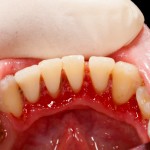
The prevalence of periodontal disease is high worldwide and is rising in some countries. Subgingival mechanical debridement by means of scaling and root planing (SRP) is an effective treatment but this can be uncomfortable and painful for some with a large proportion of patients needing to be treated under local anaesthesia. As a large proportion of patients are apprehensive of conventionally (needle) delivered local anaesthesia topical sulcular anaesthesia alternatives have been tested with the aim of replacing local anaesthetic injection.
The aim of this review was to assess the effectiveness of intra-pocket anaesthesia in reducing pain during periodontal probing or SRP.
Methods
Searches were conducted in the following databases; Medline, Scopus, Web of Science, LILACS, BBO, Cochrane Library, SIGLE, ProQuest Dissertations and Theses, Periódicos Capes Theses, Current Controlled Trials, International Clinical Trials Registry Platform, the ClinicalTrials.gov, Rebec (www.rebec.gov.br ), EU Clinical Trials Register (www.clinicaltrialsregister.eu), abstracts of the annual conference of the International Association for Dental Research (IADR) and its regional divisions.
Randomised controlled trials, parallel, crossover or split-mouth designs comparing intra-pocket anaesthesia with an anaesthetic gel with placebo in patients requiring periodontal probing or SRP were considered. Two reviewers selected studies with 3 reviewers abstracting data. Study quality was assessed independently by two reviewers using the Cochrane Risk of bias tool. Pain intensity was summaries using standardised mean difference and risk of pain using odds ratios (OR).
Results
- 11 studies were included.
- Most patients had periodontal disease with a probing pockets depth (PPD) of ≥5 mm
- The number of patients varies from 15-300
- A range of products were tested and the time that the anaesthetic gel was left in the pocket before starting the probing and SRP procedures varied from 30sec to 5mins.
- 9 studies were considered to be at low risk of bias and 2 at high risk.
- Standardized Hedge’s g mean difference for pain intensity using visual analogue scale and Heft-Parker pain scales (7 studies) = -0.576 (95%CI; -0.94 to -0.22; p = 0.002) and
- for verbal rating scale pain scale (5 studies) = -1.814 (95% CI -3.38 to -0.245; p = 0.023).
- OR for the risk of pain (5 studies)= 0.025 (95%CI; 0.003 to 0.25; p = 0.002)
- OR for the need for rescue anaesthesia (5 studies) =0.358 (95% CI 0.174 to 0.736; p = 0.005).
Conclusions
The authors concluded: –
Topical anaesthesia was superior to placebo during probing, SRP as it reduced the risk and intensity of pain and the need for rescue anaesthesia during periodontal diagnosis and treatment.
Comments
The reviewers performed and extensive literature search fro this review identifying 11 studies and only using the 9 low risk trials for the meta-analysis. Not unexpectedly a positive impact on pain reduction was seen with the use of local anaesthetic. The included studies have a good deal of variation in both the anaesthetic agent (lignocaine, prilocaine, benzocaine, tetracaine) and the vehicle used (gels, creams). There is also variation in the time from application to treatment and while the trialists used manufactures recommended times many of the studies indicated a need for rescue medication. While this review suggest that intra-pocket anaesthesia helps reduce pain and discomfort from SRP more research is needed to identify the most effective agent, delivery system and time to treatment as an alternative to local anaesthetic injection.
Links
Primary paper
Wambier LM, de Geus JL, Chibinski AC, Wambier DS, Rego RO, Loguercio AD, Reis A. Intra-pocket anaesthesia and pain during probing, scaling and root planing: a systematic review and meta-analysis. J Clin Periodontol. 2016 Sep;43(9):754-66. doi: 10.1111/jcpe.12565. Epub 2016 Jul 15. Review. PubMed PMID: 27097588.
Other references
Original review protocol on PROSPERO database

intra-pocket anaesthesia for periodontal treatment https://t.co/PUQ6xSzCqz
[…] post Periodontal treatment: effectiveness of intra-pocket anaesthesia appeared first on National Elf […]
Periodontal treatment: effectiveness of intra-pocket anaesthesia https://t.co/PUQ6xSzCqz
Topical intra-pocket anaesthesia reduced pain during scaling and root planing https://t.co/PUQ6xSzCqz
Pain reduced during scaling and root planing with topical intra-pocket anaesthesia https://t.co/PUQ6xSzCqz
Risk of pain during scaling and root planing reduced with topical intra-pocket anaesthesia https://t.co/PUQ6xSzCqz
Don’t miss – Periodontal treatment: effectiveness of intra-pocket anaesthesia https://t.co/PUQ6xSzCqz